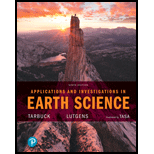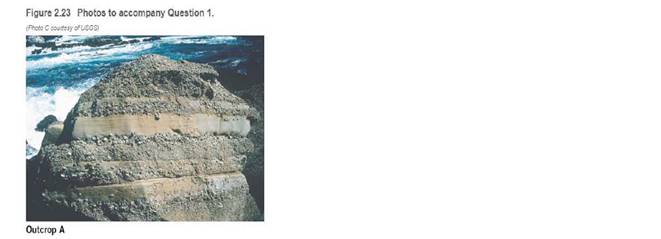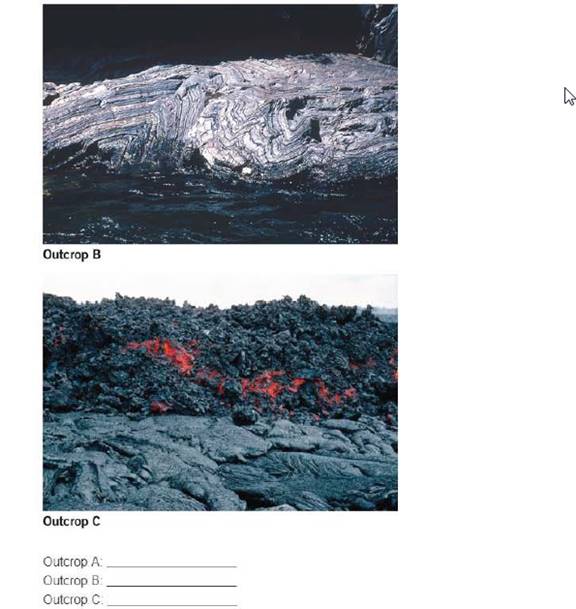
The rock samples you encountered while completing this exercise are called hand samples because you can pick them up 10 your hand and study them You can also easily examine hand samples with a hand lens, test them for hardness and reactivity to HCl, and feel and heft them. However, some charactenstlcs of each rock group are so diagnostic that you can observe them at a distance and classify the rocks as Igneous, sedimentary, or metamorphic Examine the rock outcrops shown in Figure 2.23 and determine whether each is igneous, sedimentary. or metamorphic


Introduction:
The rocks are divided into three primary categories. These categories are sedimentary, igneous, and metamorphic rocks. The difference in these rocks lies in the process of formation of the rocks.
Answer to Problem 1LR
Correct answer:
The outcrop A depicts sedimentary rock, outcrop B is metamorphic rock, and outcrop C depicts igneous rocks.
Explanation of Solution
The three types of rocks are igneous rocks, sedimentary rocks, and metamorphic rocks. The igneous rocks are formed after the cooling and hardening of magma. The sedimentary rocks are formed from the aggregation of the sediments that is of different size and nature. The metamorphic rocks are formed under the process of metamorphosis that takes place under high temperature and pressure.
Want to see more full solutions like this?
Chapter 2 Solutions
Applications and Investigations in Earth Science (9th Edition)
Additional Science Textbook Solutions
Concepts of Genetics (12th Edition)
Chemistry: An Introduction to General, Organic, and Biological Chemistry (13th Edition)
Human Physiology: An Integrated Approach (8th Edition)
Campbell Biology (11th Edition)
Microbiology: An Introduction
Anatomy & Physiology (6th Edition)
- On the map in Figure 6.21, write the word oldest where the oldest sedimentary rock unit is exposed at the sur-face and the word youngest where the youngest sedimentary rocks occur.arrow_forwardDiscussion Question: Glacial (or Ice) and Periglacial Landscapes A+ The Ice and Glaciers chapter focuses on the Cryosphere, the ice on our planet. I always find it interesting to consider the Earth's Hydrologic Cycle, our water in all of the different phases: solid ice, liquid water, and water vapor (a gas). In place number one for the majority of the World's water, we have the oceans. In place number two, we have ice. Neither one is available to us for drinking water at this point. Amazingly enough, in place number three is groundwater before lakes and streams. Water has led to many problems in the history of California, the United States, and even the world. Nevada Idaho B) at Flats el Mone Lake Arizona Severe Dry Lake (c) Mono Lake, tufa towersarrow_forwardDiscussion Question: River (or Stream) Systems A+ Should New Orleans have been reconstructed or not? 94 (b) 40 80 MILES Louisiana 40 80 KILOMETERS Old River Control Project Alexandria 93 Gulf of Mexico 92 Lake Pontobartrain Now Orleans Morgan City H High pressure PACIFIC OCEAN 30- General region of 150%+ precipitation during summer CP Cool, dry air Jer stream shed south Divergence mT air mass is pumped into the Midwest for weeks 400 800 MILES 400 800 KILOMETERS 120° Heal wave High pressure Stagnant air m Warm, wet unstable ATLANTIC OCEAN Tropic of Cancer 91 89 ° 110° 70°arrow_forward
- Los Angeles's demand for water exceeds the amount of water available. There are no other new sources of water available, so Los Angeles is planning on constructing the high technology facilities necessary to produce drinking water from treated municipal wastewater (i.e. "Toilet to Tap"). Public perception (i.e. the "yuch! factor"), not well established, proven technology, to accomplish this task, is going to be the big problem. Develop a five (5) item marketing plan to convince the "beautiful" people of Los Angeles that drinking water that is recycled sewage that exceeds all U.S. EPA drinking water standards. This can be done because as Slide 63 shows, doctors once were used to sell Lucky Strike cigarettes - "Your throat protection: against irritation, against cough". Cigarettes, as is now known are harmful to your health while the drinking water produced from sewage is of equal quality and in many instances higher quality than your existing drinking water.arrow_forwardRead June 17, 2023, editorial from the Wall Street Journal entitled "Biden's Fishy Plan to Breach the Snake River Dams. The editorial raises a number of concerns about the plans of the administration of President Joseph Robinette Biden to remove four hydroelectric dams from the Snake River in southeastern Washington. Your responsibility for this Exercise is to list five (5) of the concerns raised in the editorial and provide fact-based arguments (NOT YOUR PERSONAL OPINION), including references from sources other than the editorial, either supporting or disagreeing with each of the five (5) concerns.arrow_forwardShould the United States allow Mexico to have water from the Rio Grande and the Colorado River, both of which originate in the United States and flow to Mexico?arrow_forward
- What are the similarities between domestic and industrial water use? How are they different from in-stream use?arrow_forwardDo you believe that large-scale hydroelectric power plants should be promoted as a renewable alternative to power plants that burn fossil fuels? What criteria do you use for this decision?arrow_forwardDo nonfarmers have an interest in how water is used for irrigation? Under what conditions should the general public be involved in making these decisions along with the farmers who are directly involved?arrow_forward
 Applications and Investigations in Earth Science ...Earth ScienceISBN:9780134746241Author:Edward J. Tarbuck, Frederick K. Lutgens, Dennis G. TasaPublisher:PEARSON
Applications and Investigations in Earth Science ...Earth ScienceISBN:9780134746241Author:Edward J. Tarbuck, Frederick K. Lutgens, Dennis G. TasaPublisher:PEARSON Exercises for Weather & Climate (9th Edition)Earth ScienceISBN:9780134041360Author:Greg CarbonePublisher:PEARSON
Exercises for Weather & Climate (9th Edition)Earth ScienceISBN:9780134041360Author:Greg CarbonePublisher:PEARSON Environmental ScienceEarth ScienceISBN:9781260153125Author:William P Cunningham Prof., Mary Ann Cunningham ProfessorPublisher:McGraw-Hill Education
Environmental ScienceEarth ScienceISBN:9781260153125Author:William P Cunningham Prof., Mary Ann Cunningham ProfessorPublisher:McGraw-Hill Education Earth Science (15th Edition)Earth ScienceISBN:9780134543536Author:Edward J. Tarbuck, Frederick K. Lutgens, Dennis G. TasaPublisher:PEARSON
Earth Science (15th Edition)Earth ScienceISBN:9780134543536Author:Edward J. Tarbuck, Frederick K. Lutgens, Dennis G. TasaPublisher:PEARSON Environmental Science (MindTap Course List)Earth ScienceISBN:9781337569613Author:G. Tyler Miller, Scott SpoolmanPublisher:Cengage Learning
Environmental Science (MindTap Course List)Earth ScienceISBN:9781337569613Author:G. Tyler Miller, Scott SpoolmanPublisher:Cengage Learning Physical GeologyEarth ScienceISBN:9781259916823Author:Plummer, Charles C., CARLSON, Diane H., Hammersley, LisaPublisher:Mcgraw-hill Education,
Physical GeologyEarth ScienceISBN:9781259916823Author:Plummer, Charles C., CARLSON, Diane H., Hammersley, LisaPublisher:Mcgraw-hill Education,





